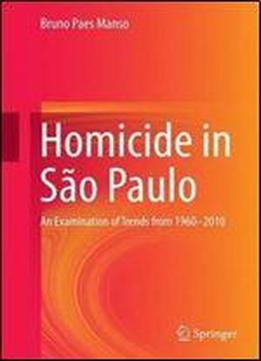
Homicide In Sao Paulo: An Examination Of Trends From 1960-2010 (springerbriefs In Criminology)
by Bruno Paes Manso /
2016 / English / PDF
3.2 MB Download
This volume aims to explain the mechanisms for the “epidemic-like” rise in homicide rates Sao Paulo, Brazil during the late 20th century as well as their sharp decrease after 2000. The homicide rates increased 900 percent from 1960s-2000, and then dropped relatively quickly to 1970s levels over the next decade. While the author finds the Brazilian military government and rise of para-military police forces to be a major factor in the rise of homicide rates in Brazil, research on violent crime trends has demonstrated that it is generally due to the intersection of many factors (for example changes in policing, social or political structures, availability of weapons, economic influences) rather than a single cause. This work integrates individual, neighborhood, and structural dynamics at play in both the rise and drop in homicide rates, and provides a framework for understanding similar phenomena in other regions, particularly in the developing world.
This book will be of interest to researchers in criminology and criminal justice, as well as political science, and international relations, particularly with an interest in South America. The methodology includes both qualitative and quantitative analysisAuthors: Manso, Bruno Paes
Examines violent crime trends in So Paulo, Brazil
Presents an integrated, contextual explanation for homicide trends
Provides a unique view into the historical, cultural, and political landscape of So Paulo from 1960-2010
This volume aims to explain the mechanisms for the epidemic-like rise in homicide rates So Paulo, Brazil during the late 20th century as well as their sharp decrease after 2000. The homicide rates increased 900 percent from 1960s-2000, and then dropped relatively quickly to 1970s levels over the next decade. While the author finds the Brazilian military government and rise of para-military police forces to be a major factor in the rise of homicide rates in Brazil, research on violent crime trends has demonstrated that it is generally due to the intersection of many factors (for example changes in policing, social or political structures, availability of weapons, economic influences) rather than a single cause. This work integrates individual, neighborhood, and structural dynamics at play in both the rise and drop in homicide rates, and provides a framework for understanding similar phenomena in other regions, particularly in the developing world.
This book will be of interest to researchers in criminology and criminal justice, as well as political science, and international relations, particularly with an interest in South America. The methodology includes both qualitative and quantitative analysis.
Number of Illustrations and Tables
21 illustrations in colour
Topics
Criminology & Criminal Justice
Political Science











